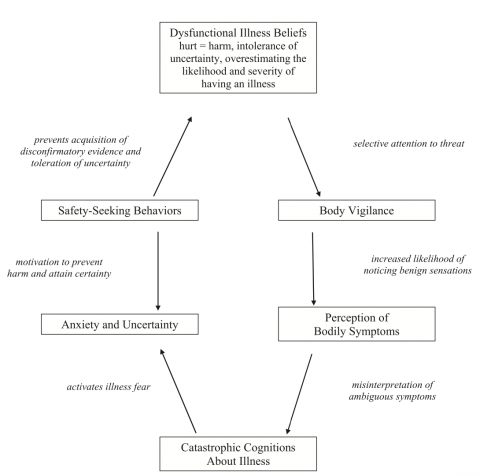Health anxiety sucks. At times, there can be seemingly constant flux of bodily sensations or symptoms to worry about. A headache, random heart palpitation or stomach ache can send you into a tailspin of worries, anxiety, body checking, googling, doctor visits, scans and tests. The whole process is exhausting. So, what is happening behind the scenes?
Cognitive researchers delineate a common process that takes place among those with health anxiety that includes a variety of thoughts and behaviors. See the diagram below as outlined by Abramowitz et al. (2007).

As you can see, there is a whole lot happening here. This process ultimately becomes a vicious cycle that can be difficult to stop. At some point, you have developed certain inaccurate or dysfunctional beliefs, assumptions and thoughts about health and illness. Because of this, you pay very close attention to any bodily sensations. Any time a new bodily sensation or symptom appears, you begin to imagine a variety of potential explanations. Usually these explanations are not common, benign illnesses but instead are dangerous or even catastrophic illnesses (e.g., cancer, stroke, heart attack, multiple sclerosis). You then experience anxiety as a result of this newly hypothesized disease (who wouldn’t if they thought they might die?). At this point, you are in a state of great fear and feel that you must do something to save yourself from this impending doom. So you engage in “safety behaviors” or behaviors that you believe might prevent the impact of this potential disease. You might go to multiple doctors, get a range of tests done, seek reassurance from friends or family members. Once you’ve consulted with a doctor or had tests done, all is fine and dandy for a little while because you (briefly) believe you are healthy again. But then a new bodily sensation pops up (or an old one continues or reemerges) and you are back to square one again. Getting stuck in this cycle can be pretty awful!
The key here is to interrupt this cycle. Dysfunctional or inaccurate thoughts and beliefs need to be challenged to help you reshape the way you see health and disease. It is also important to help you stop using safety behaviors so that you can learn that such techniques don’t actually prevent you from getting a serious illness. All of this can be done through a range of cognitive and behavioral interventions. CBT to the rescue!

